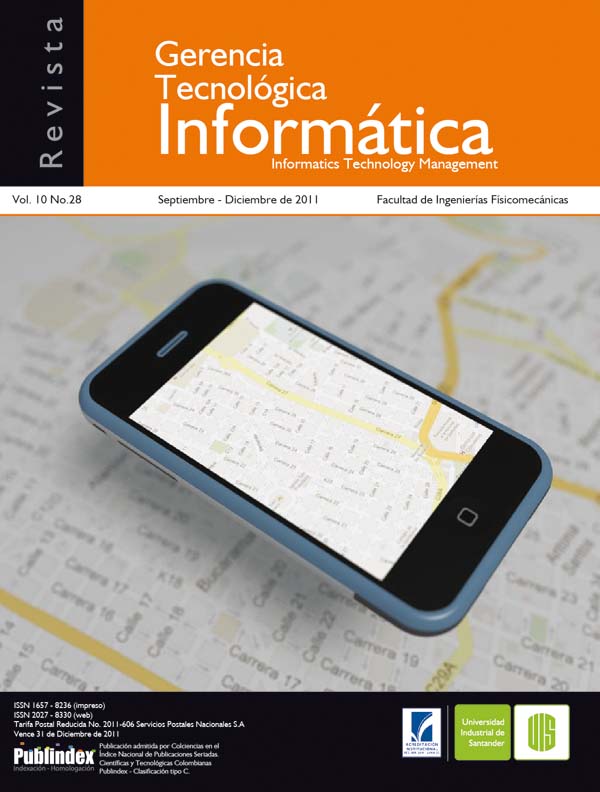SISTEMA DE ESCANEO GEO-REFERENCIADO DEL ESPECTRO RADIOELÉCTRICO – GEOSPECTSCANNER
Published 2012-09-22
How to Cite
Abstract
RESUMEN ANALITICO
El sistema de escaneo geo-referenciado del espectro radioeléctrico es una herramienta automatizada y computarizada para medir el espectro y las coordenadas geográficas asociadas en sectores urbanos alrededor de múltiples sitios, la cual se encuentra enlazada, a través de internet, con una Plataforma Tecnológica de Servicios que se encarga de almacenar en tiempo real la información registrada por los instrumentos de medición en campo y permite su posterior consulta vía web sobre mapas geográficos. En este artículo hace una descripción del sistema desarrollado y las funcionalidades principales
PALABRAS CLAVES: Espectro radioeléctrico, Drive-test, Mapas de espectro, Plataforma de servicios
GEO-REFERENCED SCANNING SYSTEM OF RADIO SPECTRUM-GEOSPECTSCANNER
ANALYTICAL SUMMARY
The scanning system of geo-referenced spectrum is an automated, computerized tool to measure the spectrum and the geographic coordinates associated in urban areas across multiple sites, which is linked through the Internet, with Services Technology Platform which is responsible for storing real time information recorded by the field measurement instruments and allows further consultation via the web on maps. This article gives a description of the developed system and main features
KEY WORDS:Spectrum, Drive-test, Map of radio spectrum, Services Platform
Downloads
References
- . J. Schiller y A. Voisard. “Location Based Services”. Amsterdam, Editorial Elservier. 2004. 253 p.
- . “ITU-R SM.1537 Automation and integration of spectrum monitoring systems with automated spectrum management”. International Telecommunication Union. 2001. Disponible en: http://www.itu.int/rec/R-RECSM.1537/es [citado enero 2011]
- . “ITU-R SM.1048 Design guidelines for a basic automated spectrum management system (BASMS)”. International Telecommunication Union. 1994. Disponible en: http:// www.itu.int/rec/R-REC-SM.1048/es [citado enero 2011]
- . “ITU-R SM.182-5 Automatic monitoring of occupancy of the radio-frequency spectrum”. International Telecommunication Union. 2007. Disponible en: http:// www.itu.int/rec/R-REC-SM.182-5-200702-W/es [citado enero 2011]
- . P. Raush, J. Kub, and E. Gray. “Automatic Radio Frequency Monitoring Measurements”. Institute for Telecommunication Sciences. Electromagnetic Compatibility, 1999 IEEE International Symposium on. Seattle. ISBN: 0-7803-5057-X. US. 2002.
- . W. Pinglian, Y. Sumin. “Automated Measurement System for Wireless Transmitters”. Academy of electro-optics, Chinese Academy of Science. Electronic Measurement and Instruments, 2007. ICEMI '07. ISBN: 978-1-4244- 1136-8 China. 2007
- . J. Giesbrecht. “A Monitoring Tool for HF Frequency Management and License Enforcement”. University of Adelaide. Ionospheric Radio Systems and Techniques. ISSN: 0537-9989. Australia. 2006
- . R&S ZVL Vector Network analyzer. Operating manual. Rohde&Schwarz. Munich. Alemania. 2008. Disponible en: http://www2.rohde-schwarz.com/en/products/ test_and_measurement/network_analysis/ZVL-%7CManuals-%7C-22-%7C-2348-%7C-2348.html [citado enero 2011]
- . Unión Internacional de Telecomunicaciones (UIT), Recomendación UIT-T K.52. “Orientación sobre el cumplimiento de los límites de exposición de las personas a los campos electromagnéticos”, Febrero de 2000. Disponible en: http://www.itu.int/itu-t/ recommendations/index.aspx?ser=K.[Citado febrero de 2011]
- . Ministerio de Tecnologías de Información y las Comunicaciones de Colombia. Decreto 195 de 2005. Colombia. 2005. Disponible en: http://www. cntv.org.co/cntv_bop/basedoc/decreto/2005/ decreto_0195_2005.html. [Citado febrero de 2011].
- . D. Vega, S. López, J. Matías, U. Gil, I. Peña, M. Vélez. “Generalization of the Lee Method for the Analysis of the Signal Variability”. IEEE transactions on vehicular technology. 2009, vol. 58, no2, pp. 506-516. ISSN: 0018-9545. University of the Basque Country. España
- . The International EMF Project. World Health Organization (WHO). Consultado en febrero de 2011. Disponible en: http://www.who.int/pehemf/project/en/
